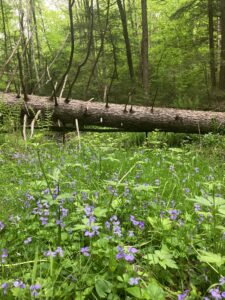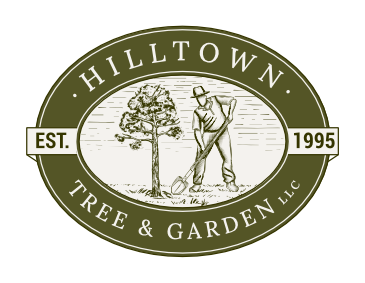Improving the Health of your Landscape with Native Plants

Did you know that your yard can act as a functional ecosystem and contribute to the health of our planet? The definition of an ecosystem is “a community of living organisms (plants, animals, microbes) interacting with their physical environment within a specific geographical area.” When native species evolve together, they are able to coexist in an intricate web of life- they depend on each other. Whether that is for food, shelter, or keeping each other’s population in check (example: nut-producing trees keeping squirrels in check using mast years), without each other, the system is disrupted and no longer thrives.
Native plants are not just vital in restoring ecosystems, they are part of the ecosystem. In Western Massachusetts, a rising problem is invasive plants. Invasives thrive in disrupted areas, and this includes our own backyards. It is important to manage these aggressive plants immediately and using the correct method, as they are prone to spreading rapidly. Even if invasives are not a current issue, the health of your property can be greatly improved with the addition of native plants. Whether your property consists of a lawn, field, forest, or swamp, there is a native plant able to adapt and thrive to your local conditions.

Often, plants are selected for aesthetic value instead of beneficial qualities. Luckily, the beauty of your landscape does not have to be compromised by sourcing only native plants! While not always the uniform, conventional look, there are thousands of species of plants that provide year-round show. Take for example, the Hobblebush Viburnum (Viburnum lantanoides), a native woodland shrub with great seasonal interest. In the spring, its large white floral disks are some of the first blooms to arrive. In Summer they are followed by red berries that are loved by the birds. Come fall, the green foliage turns a striking magenta. In Winter after the shrub has lost its leaves, it remains visually appealing due to its unique architecture, consisting of low, horizontal branches.
Aesthetic values
Choosing to incorporate native plants does not mean abolishing all of your non-native plants or replacing your lawn. Providing no aggressive or invasive species are present, the natives and non natives can coexist. This provides a landscape that is both functional, eco friendly, and aesthetically appealing.
What can Hilltown do?

The process of restoring your landscape to its natural ecosystem can be done in multiple steps. Because Native plants are adapted to grow in different types of environments, it’s smart to take advantage of the naturally occurring ecosystem. Grasses and other water-loving plants prevent erosion along stream beds while providing habitat for amphibians and other animals. In forests where there is little to no undergrowth, shade tolerant shrubs and groundcovers can be supplemented throughout, adding greenery and flowers beneath the tree canopy. Lawns provide a great place for children to play and people to gather. However, some homeowners find the cost and labor of maintaining a space they rarely use is not worth it, or they simply would rather a more sustainable option. This is where wildflower meadows come into play. Meadows provide color in the warmer months and free bird seed when it gets cold, while only having to be mown once a year! Invasive plants can be removed using different tactics, and replaced with better options.

